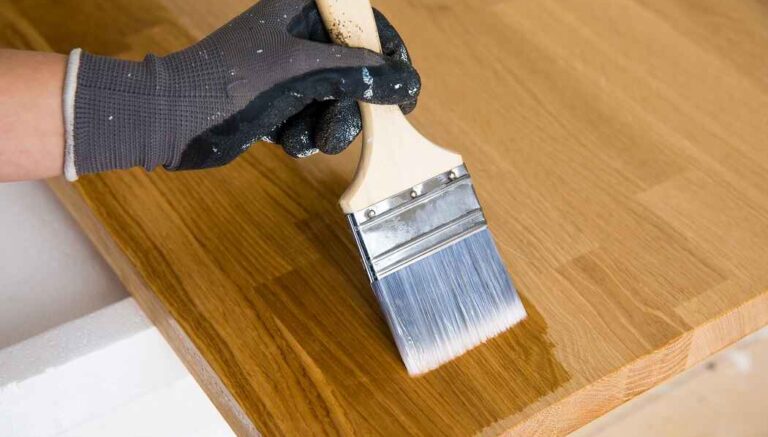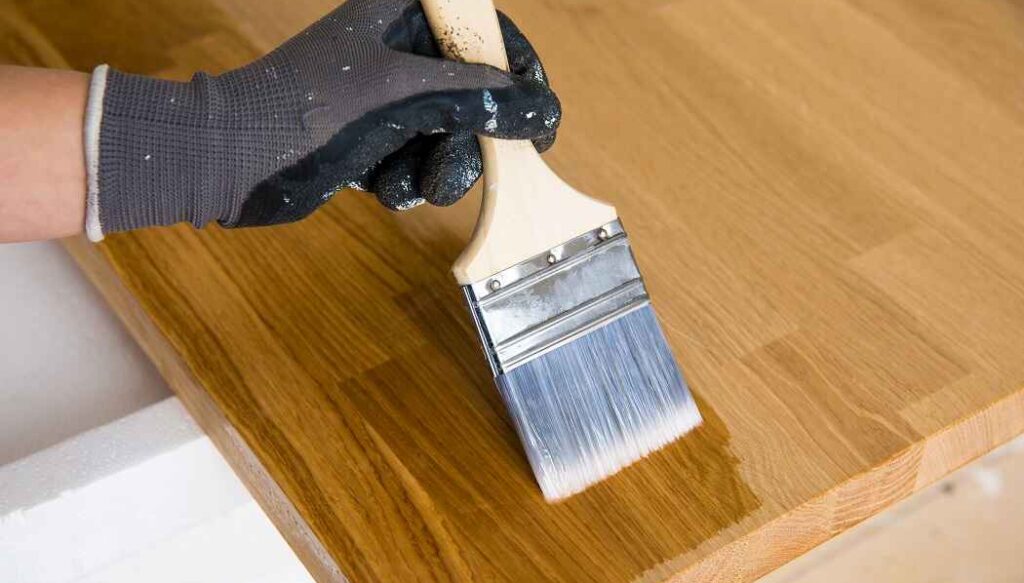
Is Solid Stain the Same as Paint? A Comparative Analysis
When it comes to selecting the right product to protect and enhance the appearance of wooden surfaces, the choices can seem overwhelming. Among the various options available, two popular choices are solid stain and paint.
Although both solid stain and paint share some similarities in their application and purpose, they are not quite the same. Understanding the differences between these two products is vital for DIY enthusiasts seeking the ideal solution to achieve their desired results.

In this exploration of solid stain versus paint, we will dig into the distinctive characteristics, applications, and benefits of each product. By the end, you will gain valuable insights into which option best suits your project, be it a deck, fence, siding, or other wooden structures.
What Is Solid Stain Used For?
Solid stain is used primarily as a protective and decorative finish for exterior wood surfaces. It is a type of wood stain that contains a high concentration of pigments and offers a thicker consistency than semi-transparent or transparent stains.
The main purpose of using solid stain is to enhance the appearance of the wood while also providing durable protection against the elements. It effectively covers the natural grain and texture of the wood. Moreover, it gives the wood a more uniform color and a painted-like finish. Solid stain works well on weathered or aged wood, as it can help hide imperfections and provide a fresh look.
Solid stain penetrates the wood, allowing it to breathe and preventing the risk of peeling or cracking. It’s an excellent choice for those seeking a long-lasting solution to preserve and beautify their exterior wood structures.
Is Solid Stain the Same as Paint?
Solid stain and paint are similar in that they both add color to a surface, but they are not the same. The key difference between the two lies in their transparency and how they interact with the underlying material.
Solid stain is designed to penetrate the surface, bonding with the wood or other materials. It provides a semi-opaque finish, allowing some of the natural texture and grain to show through while still providing a uniform color. This makes solid stain a popular choice for outdoor applications, such as decks and fences, where the wood’s natural beauty is desirable. Solid stains also tend to be more durable than paint, as they are less likely to peel or crack, making them a practical choice for surfaces exposed to the elements.
Paint, on the other hand, is more opaque and forms a thicker, more protective layer on the surface. It completely covers the underlying material, obscuring its texture and grain. While paint offers a wide range of colors and finishes, it is typically less suited for outdoor wood surfaces due to its tendency to peel or chip over time when exposed to moisture and UV rays.
In summary, solid stain and paint are not the same. Solid stain is a semi-opaque finish that penetrates and bonds with the surface, allowing some of the natural material to show through. It is a preferred choice for outdoor wood surfaces due to its durability. Paint, in contrast, is more opaque, completely covering the surface, but is better suited for indoor applications or surfaces less exposed to the elements due to its tendency to deteriorate over time when exposed to moisture and UV rays.
Does Solid Stain Cover like Paint?
Solid stain functions similarly to paint in terms of providing a covering layer over the surface of wood. However, the key difference lies in their transparency. Solid stain, as the name suggests, offers more opacity than regular semi-transparent or transparent stains. It still allows the texture of the material to show through, but it covers the underlying color or imperfections more effectively.
Solid stain provides better coverage for concealing blemishes, discolorations, and previous coatings. It is ideal for weathered surfaces, where paint might not adhere well due to peeling or flaking. Solid stain is also commonly used to change the color of wood without completely hiding the grain pattern.
Key Similarities between Solid Stain and Paint
While solid stain and paint both have distinct characteristics and purposes, there are key similarities between them.
Protective Qualities: Both solid stain and paint offer protection against environmental elements. They form a protective barrier over the surface, preventing water penetration and reducing the risk of rot and decay.
Hiding Imperfections: Both finishes are effective at concealing imperfections in the wood, such as knots and discolorations. The opaque nature of solid stains and paints makes them ideal for hiding surface blemishes.
Application Methods: Solid stains and paints are applied in similar ways using brushes, rollers, or sprayers. They require surface preparation, such as cleaning and sanding, to ensure proper adhesion and longevity of the finish.
Longevity: When properly applied and maintained, solid stains and paints can have similar lifespans. They both offer good durability and can last several years before requiring recoating.
Different Formulations: Both solid stains and paints are available in water-based and oil-based formulations. Water-based options are generally more environmentally friendly and dry faster. Oil-based products may provide better penetration and adhesion on certain wood types.
Clean-up: Cleaning up after application is similar for solid stains and paints. Tools and brushes can be cleaned with soap and water for water-based products, while mineral spirits or paint thinner are used for oil-based products.
Key Differences between Solid Stain and Paint
Despite some similarities, they have significant differences that make them suitable for different applications.
Transparency and Texture: Solid stain allows the texture and grain of the wood to be visible. It imparts color to the wood while maintaining a more natural appearance. Paint creates an opaque film over the surface. It provides a uniform and smooth finish with no visible wood characteristics.
Color Opacity: As the name suggests, solid stains offer solid, consistent color opacity. They provide excellent coverage, hiding imperfections throughout the surface. Paint comes in a wide range of opacity levels, including various levels of coverage from semi-transparent to fully opaque.
Durability: Solid stains penetrate the wood and provide a strong bond with the surface. But it may show signs of wear and fading more gradually over time. Paint provides excellent durability to various environmental elements, typically lasting longer without significant signs of wear.
Maintenance: Solid stains require less maintenance compared painting, as they tend to wear more gracefully. Painted surfaces may require more frequent maintenance, as the paint film can chip, crack, or peel over time.
Breathability: Solid stains allow the wood to breathe to some extent since they penetrate the surface. Paint forms a non-breathable barrier on the wood’s surface. It can lead to trapping moisture within the wood.
Check This Video:
Factors to Consider while Choosing between Solid Stain and Paint
Choosing between solid stain and paint depends on many factors like the surface you’re working on, the desired appearance, and environmental considerations. Here are some factors to consider for each option.
1. Surface Material:
- Consider the material you’re working with. Solid stain is typically best for wood, while paint can be used on various surfaces, including wood, metal, and concrete.
2. Aesthetics:
- Determine the desired finish. Solid stain allows the wood grain to show through, offering a more natural appearance. Paint, on the other hand, provides a smooth, opaque finish.
3. Color Options:
- Both solid stain and paint offer a wide range of color options. Decide if you want a specific color or if you prefer the natural color of the material with solid stain.
4. Longevity:
- Solid stain tends to penetrate the wood and can offer better protection against moisture and UV damage. Paint can also protect, but it may require more maintenance to keep it looking good over time.
5. Maintenance:
- Consider how much maintenance you’re willing to perform. Solid stain is generally easier to maintain than paint because it doesn’t peel. Paint may require scraping and repainting as it ages.
6. Weather Resistance:
- Think about the climate in your area. If you live in a region with extreme weather conditions, solid stain may be more durable and resistant to cracking and peeling.
7. Application and Preparation:
- Assess the condition of the surface. Paint often requires more preparation, such as priming, sanding, and filling cracks, whereas solid stain is more forgiving of imperfections.
8. Coverage:
- Solid stain typically allows the wood’s texture to show through, while paint provides a completely uniform finish. Consider if you want to hide imperfections or highlight the texture of the material.
9. Cost:
- Compare the cost of materials and labor for both options. Solid stain is often less expensive and easier to apply.
10. Environmental Impact:
- Consider the environmental implications. Some paints may contain harmful chemicals, while water-based options and low-VOC (volatile organic compound) products are more eco-friendly.
11. Local Regulations:
- Check for any local regulations or restrictions on the use of certain paints or stains, especially in terms of environmental impact.
12. Personal Preferences:
- Your personal taste and style play a significant role. Some people prefer the look and feel of natural wood, while others prefer the uniform appearance of paint.
13. Application Method:
- Consider your preferred application method. Paint is typically applied with brushes, rollers, or sprayers, while solid stain can be applied similarly but with different effects.
14. Durability:
- Think about the level of wear and tear your surface will endure. Solid stain may hold up better on high-traffic areas, while paint may be better for areas where you want a smooth, easily washable surface.
15. Project Size:
- The size and scope of your project can influence your decision. Larger projects may be more cost-effective with one option over the other.
Take the time to weigh these factors carefully, and if you’re unsure, consider consulting with a professional or seeking advice from a local paint or home improvement store.
You Can Also Check This Video:
Final Words
The decision between solid stain and paint ultimately depends on the specific requirements of the project. Careful consideration of these factors will help determine which option is most suitable.
Solid stain and paint have their unique characteristics, advantages, and applications. Understanding their differences allows for informed decision-making and ensures the best results for any surface treatment project.
